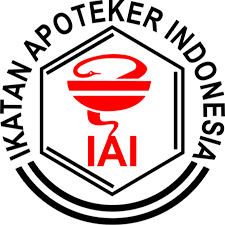Focus Group Discussion (FGD) dengan Interprofessional Education (IPE) sebagai Alternatif Peningkatan Pengetahuan Tenaga Kesehatan tentang Kontrasepsi Oral dan Suntik di Kota Bandung
Ikhwan Yuda Kusuma(1*), Doni Anshar Nuari(2), Kusnandar Anggadiredja(3)(1) Program Studi Farmasi,Universitas Harapan Bangsa, Jl. Raden Patah No.100, Banyumas, Indonesia
(2) Jurusan Farmasi, Universitas Garut, Jl. Raya Samarang No.52a, Garut, Indonesia
(3) Sekolah Farmasi, Institut Teknologi Bandung, Jl. Ganesha No.10, Lb. Siliwangi, Bandung, Indonesia
(*) Corresponding Author
Abstract
The drop out rate of contraceptive use in Indonesia until 2016 still high at 25.7% of the government's target of 24%, this the optimization of the performance of health personnel should be improved, especially regarding health personnel knowledge about the use of oral and contraceptives which is the largest user in the city of Bandung. One of the efforts to improve the quality of family planning programs, through increasing the competence of health workers called Interprofessional Education (IPE). The purpose of this study was to identify the level of knowledge of health personnel at the health center regarding oral and injection contraceptives between professions with IPE in Bandung. This research used an experimental method with the type of group pre-posttest design. Data were analyzed using the Wilcoxon rank test from a questionnaire on health personnel's knowledge about oral and injection contraceptives on IPE before, and after Focus Group Discussion (FGD). The results showed there was an increase in the level of knowledge in 152 health personnel, a decrease in the level of knowledge in 5 health personnel, and no change in the four health personnel. Focus Group Discussion (FGD) through Interprofessional Education (IPE) was proven to significantly increase knowledge about oral contraceptives and injections on health personnel at the Health Center.
Keywords
Full Text:
PDFReferences
Allen, R. H. and Cwiak, C. A., 2014. Contraception for the Medically Challenging Patient. Edited by R. H. Allen and C. A. Cwiak. New York, NY: Springer New York.
Badan Pusat Statistik Indonesia. 2013. Proyeksi Penduduk Indonesia Indonesia Population Projection 2010-2035. Jakarta: Badan Pusat Statistik Indonesia.
Barr, H. and Low, H., 2013. CAIPE: Introducing Interprofessional Education. Fareham: CAIPE.
BKKBN. 2017. Sinergi Dukungan Kegiatan dan Anggaran BKKBN dalam Peningkatan Pelayanan KB di Fasilitas Kesehatan. Jakarta: Badan Kependudukan dan Keluarga Berencana Nasional.
Cappiello, J., Levi, A. and Nothnagle, M., 2016. Core competencies in sexual and reproductive health for the interprofessional primary care team. Elsevier. Elsevier Inc, 93, pp. 438–445.
Evans, E. W., Bigler, T., Murray, L., and Wright, C., 2017. Improving knowledge and attitudes of physician assistant and occupational therapy students using interprofessional case studies: Lessons learned, Journal of Interprofessional Education & Practice. Elsevier Inc, 6, pp. 45–48.
Fallatah, H. I., Jabbad, R. and Fallatah, H. K., 2015. Interprofessional Education as a Need: The Perception of Medical, Nursing Students and Graduates of Medical College at King Abdulaziz University’, Scientific Research Publishing. Jeddah, 6, pp. 248–254.
Jones, D. S. 2010. Statistik Farmasi. Jakarta: Penerbit Buku Kedokteran EGC.
Kemenkes. 2014a. Pedoman Manajemen: Pelayanan Keluarga Berencana. Jakarta: Direktorat Jenderal Bina Kesehatan Ibu Kemenkes.
Kemenkes. 2014b. Peraturan Menteri Kesehatan Republik Indonesia Nomor 75 Tahun 2014 tentang Pusat Kesehatan Masyarakat. Jakarta: Kementerian Kesehatan Republik Indonesia.
Kemenkes. 2015. Rencana Strategis Kementerian Kesehatan 2015 - 2019. Indonesia: Kementerian Kesehatan Republik Indonesia.
Kim, J., Sinclair, L., Lowe, M., Srinivasan, V., Gairy, P., 2010. Enhancing capacity for interprofessional collaboration: A resource to support program planning. Toronto: Toronto Rehabilitation Institute.
Levi, A., Burdette, L., Hill-Besinque, K., and Murphy, P. A., 2013. The interprofessional sexual and reproductive health care team. Elsevier. Elsevier Inc., 88, pp. 213–214.
Maeno, T., Takayashiki, A., Anme, T., Tohno, E., Maeno, T., and Hara, A., 2013. Japanese students’ perception of their learning from an interprofessional education program: a qualitative study. International Journal of Medical Education, 4, pp. 9–17.
Parsell, G. and Bligh, J., 1999. The development of a questionnaire to assess the readiness of health care students for interprofessional learning (RIPLS). Medical Education, 33, pp. 95–100.
Senanayake, P. and Potts, M., 2008. Atlas of Contraception 2nd edition. Journal of Obstetrics and Gynaecology, Chennai: ReplikaPress Pvt Ltd, 28(6), pp. 665–665.
Sugiyono. 2016. Metode Penelitian Kuantitatif, kualitatif dan R & D. Bandung: Alfa Beta.
Swarjana, I. K. 2016. Statistik Kesehatan. Yogyakarta: CV Andi Offset.
Article Metrics
Abstract view(s): 1321 time(s)PDF: 1122 time(s)
Refbacks
- There are currently no refbacks.








